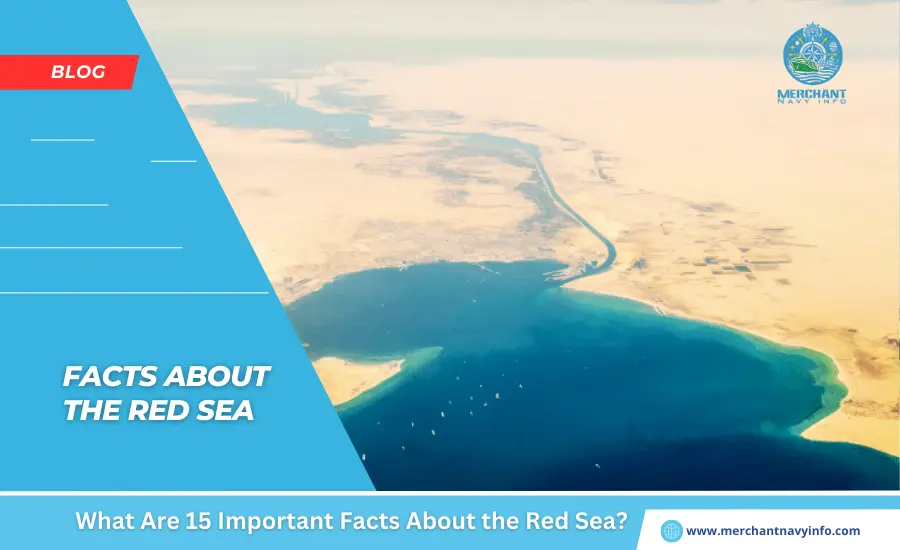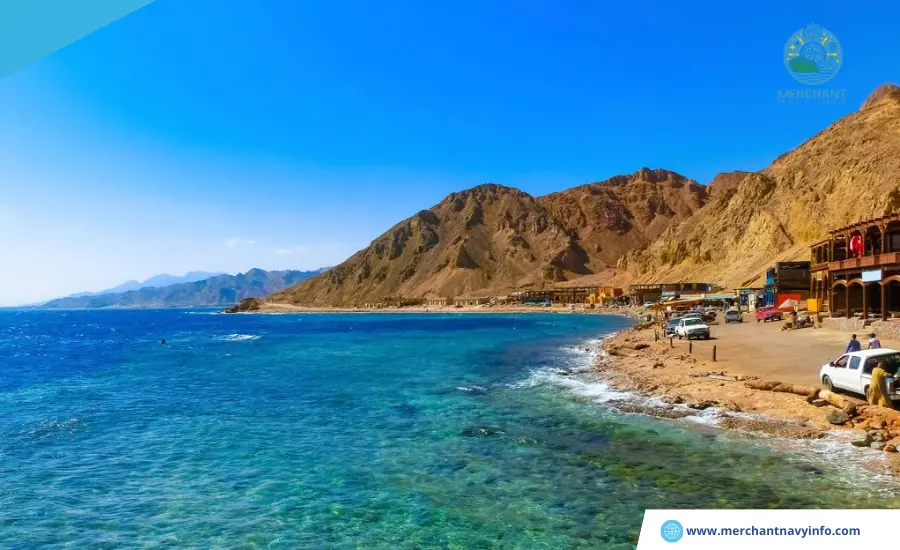
Located between the African and Asian continents. The red sea facts is an important body of water in terms of international trade, tourism, and the rich and diverse marine life it supports. The red sea facts is a gulf of the Indian Ocean, connected to the south by the Strait of Bah el-Mandeb. And the Gulf of Aden and to the north by the Sinai Peninsula, the Gulf of Aqaba, and the Gulf of Suez.
The region is home to a number of important ports and jetties that handle a large portion of the world’s cargo, as well as attractive beaches that attract people from far and wide. Not only is the red sea facts beautiful, but its waters are said to have health-promoting properties. Read on to find out more interesting facts about the Red Sea.
15 Important Facts about Red Sea

The World’s Northernmost Tropical Sea Covers 438,000 Km² Of The Global 200 Ecoregion.
With a surface area of about 438,000 square kilometres or 169,000 square miles, the red sea facts is 2,250 km or 1,400 miles long and 355 km wide at its widest point. It has an average depth of 490 m, reaching a maximum depth of 3,040 m in the central Suakin Trough. Forty percent of the ocean is less than 100 metres deep, and these shallow waters contain underwater shelves that are home to life in the form of colourful corals and small fish receptacles.
Various Naming Theories
There are many theories as to why the red sea facts was so named. One theory is that the aquatic bacterium Trichodesmium erythrasma blooms seasonally near the surface, staining the sea red for a time. Scientists argue that the name “Red” refers to a southern direction, just as the name of the Black Sea may refer to a northern direction. Modern scientists say this is the case in some Asian languages, where colors are used to refer to cardinal points, and historians have found evidence of this as well.
For example, Herodotus once used the terms “Red Sea” and “South Sea” interchangeably. Some also argue that the name of the Red Sea comes from a nearby red mountain range called Harei Edom. In ancient times, the Red Sea was known as Mare Mecca or the Sea of Mecca, and also as the Gulf of Arabia or the Gulf of Arabia due to its proximity to Arabia.
The Red Sea Is Mentioned In The Holy Scriptures, The Quran And The Bible
Many places in the world are mentioned in religious books, and the Red Sea is one of them. It is mentioned in both the Quran and the Bible. According to the biblical story, when the Israelites reached the Red Sea, they were pursued and stopped by the Egyptians. But God parted the sea so that the Israelites could cross the sea and reach safe land.
The Ancient Egyptians Were The First To Explore The Red Sea
To establish a trade route to Punt, the Ancient Egyptians sent sailors to explore the Red Sea. 2500 BC and 1500 BC In 400 BC, Hatshepsut, the royal wife of Pharaoh Thutmose II, made two such journeys. Darius the Great, a Persian Achaemenid ruler in the 6th century BC, explored this sea and took many measures to improve navigation. He sent men to remove stones and other obstacles. He documented it at sea and even built a canal that is now called the ancient Suez Canal. 4th century BC, Alexander the Great also sent an expedition there in 400 BC. The Periplus of the Erthulian Sea or Periplus of the Red Sea is an important historical account written by an unknown author. It contains detailed information about the ports and shipping routes around the Red Sea.
An Important Trade Route Since Ancient Times
It has always been an important trade route in various historical periods. From the reign of Augustus onwards, when the Roman Empire gained influence in the Mediterranean, the northern regions around the Red Sea, and Egypt, it was the preferred route for trade between Rome and the Indian subcontinent. Contact between Rome and China also depended on these waters. It was also known for the slave trade from Africa. In the Middle Ages, it was part of the spice trade route, and Muslim pilgrims passed through here on their way to Mecca. In the Middle Ages, it was an important part of the spice trade route.
The world’s fastest fish live in the Red Sea.
The coral reefs of the southern Red Sea are home to some of the most unique marine life. In fact, about 20% of the fish found here are found nowhere else in the world. But that’s not all. The fastest fish in the world, the sailfish, also lives in the waters of the Red Sea. The sailfish is about one meter long and can reach speeds of about 110 kilometers per hour, while humans can only reach speeds of 5 to 9 kilometers per hour. The sailfish is known not only for its lightning speed but also for its strange or unique appearance. It has a long, rounded spear near its nose, which distinguishes it from other fish species.
One Of The World’s Saltiest Bodies Of Water To Swim In
High evaporation rates and low precipitation make the Red Sea highly saline. There are also no major rivers that flow into the sea, and it has a narrow connection with the Gulf of Aden. In the south, the salinity is about 36 percent, while in the north near the Gulf of Suez it is 40 percent. Salt water is therefore heavy, so a relatively light body or human can float on the surface of the Red Sea without any problems.
Rich in mineral resources
The Red Sea is rich in many different kinds of marine flora and fauna. But it is also known for its mineral deposits, the most common being evaporites, petroleum deposits, sulphur, and phosphates. The Red Sea also has oil and natural gas reserves. The Red Sea is very difficult to navigate, as it has few natural harbours and extensive coral reefs. Not to forget the many shipwrecks found in its waters.
The Red Sea Is Home To 1,200 Species Of Fish And Extensive Coral Reefs.
The Red Sea is home to 1,200 species of fish, about 10% of which are found nowhere else in the world. This includes 42 species of deep-sea fish. These fish thrive on 2,000 kilometres of coral reefs along the coast. These are usually fringing reefs that are 5,000 to 7,000 years old and are made up mainly of Acropora and Porites corals. These reefs form plateaus and lagoons along the Red Sea coast and sometimes cylindrical features such as the Blue Hoar in Dahab. The coastal coral reefs are frequented by pelagic species, including some of the 44 species of sharks. The Red Sea is home to a diverse range of marine habitats, from grass beds to mangroves to salt pans and salt marshes. The Red Sea is also home to 157 species of sea slugs, many of which are found only here and nowhere else in the world.
A Paradise for Scuba Divers and Snorkelers
Diving and snorkeling can be enjoyed in many locations in the Red Sea. The best locations are Marsa Alam, Safaga, El Quseir, Makadi Bay, and Dahab in Egypt. They are unique because they are numerous. The Red Sea is home to several offshore coral reefs and atolls, most of which are unusual formations that defy Darwin’s classification of coral reefs and are thought to result from the high level of tectonic activity that characterizes the region. The Egyptian government has recognized the biodiversity of the Red Sea and established Ras Mohammed National Park, which offers some of the best diving sites.
One of the most popular diving and snorkeling spots in the Red Sea is Sharm el-Sheikh, at the southern tip of the Sinai Peninsula, known for its luxury resorts along Naama Bay. Marsa Alam, Egypt, is famous for its pristine beaches, the award-winning Concorde Moreen Beach Resort & Spa, and the Red Sea The Palace, which offers access to beautiful coral reefs and rich marine biodiversity.
There Are 18 Desalination Plants Along The Red Sea.
The demand for desalinated water is increasing mainly to meet the growing population of the region. And the needs of industries and factories. As a result, about 18 desalination plants are operating along the Red Sea coast. Releasing warm salt water, chlorine and antioxidants that are harmful to corals. Bleaching and killing them and causing fish diseases. This is a cause for serious concern as it could pose a serious threat to the biodiversity of the Red Sea and also affect the Red Sea fishing industry.
There Are 521 Islands In The Red Sea.
There are 521 islands in the Red Sea. More than 39 of these belong to the Red Sea State. Among them are Abu Minkar, Sahih Hasheesh, Qaysm, Umm Al Qayyan, etc. In 2016, two islands, Tiran and Sanafir, were transferred from Egypt to Saudi Arabia. Interestingly, not all of the islands in the Red Sea are centuries old. Some have been formed recently by volcanic eruptions, such as Shoran and Jadid islands. Which were scraped off in the Zubair Islands near Yemen in 2001 and 2013.
The Red Sea was formed after continental drift.
During the Eocene, Arabia and Africa began to separate, and this process continued at an accelerated pace in the Oligocene. The Red Sea and the Gulf of Aden were formed when the Arabian Plate separated from Nubia. Forming new oceans along the Red Sea and the Gulf of Aden. The Red Sea is relatively new, thought to be only 6-8 million years old.
Many Shipwrecks Lie In The Red Sea
The Red Sea Is Home To Many Historic Shipwrecks, Including The SS Thistlegorm And The SS Carnatic. The former was a British merchant navy ship during World War II. It was sunk after being bombed by German forces. The wreck lies at a depth of 30 meters or 100 feet. The latter was a British steamship carrying passengers. And cargo that sank after striking a reef in the Red Sea in 1869. Other popular wrecks include Umbria, Dunraven, and Yanis D, to name a few. All are popular with recreational divers.
The Red Sea Is Warm Most Of The Year.
The Red Sea is located near the Tropic of Cancer, which keeps it warm. The average temperature here is about 18 degrees Celsius, even in the winter months of December and January. In summer, it can easily reach 28 degrees Celsius. So, if you are planning a visit to the Red Sea. There is no need to worry as the sea remains calm and pleasant all year round.
Conclusion

The Red Sea is a remarkable body of water known for its rich marine life. It is also a popular tourist destination for diving enthusiasts and beachgoers looking to enjoy some peace and quiet. Its breathtaking scenery leaves visitors in awe of its beauty and splendor. It is also an important trade route, with a strategic location that allows thousands of ships to pass through it annually. Beautiful coral reefs, beach resorts, warm, clear waters filled with majestic creatures. And historical sites along the coast are just some of the things that draw people to the Red Sea.









